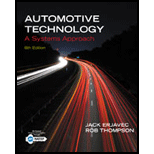
Automotive Technology: A Systems Approach (MindTap Course List)
6th Edition
ISBN: 9781133612315
Author: Jack Erjavec, Rob Thompson
Publisher: Cengage Learning
expand_more
expand_more
format_list_bulleted
Textbook Question
thumb_up100%
Chapter 34, Problem 1RQ
A rich air-fuel ratio causes HC emissions to ________.
Expert Solution & Answer
To determine
The appropriate word to fill in the blank in the statement “ A rich air-fuel causes HC emissions to _______”.
Answer to Problem 1RQ
A rich air-fuel ratio causes higher HC emissions.
Explanation of Solution
Unburned hydrocarbons are usually, vapors of gasoline that have not been burned during combustion. HC emissions illustrate that the combustion of fuel is not completed in the engine cylinder. The amount of HC depends on certain engine conditions, one of which is a rich air-fuel ratio. Whenever the mixture of air-fuel is extremely rich it causes higher HC and CO emissions.
Want to see more full solutions like this?
Subscribe now to access step-by-step solutions to millions of textbook problems written by subject matter experts!
Students have asked these similar questions
What is the definition of actual air-fuel ratio?
Explain steps involved in disconnecting a fuel line on a vehicle with multiport fuel injaction and gasoline direct injection ?
Q/ What is specific fuel consumption of an engine?
Chapter 34 Solutions
Automotive Technology: A Systems Approach (MindTap Course List)
Ch. 34 - A rich air-fuel ratio causes HC emissions to...Ch. 34 - What will result from too little EGR flow? And...Ch. 34 - What can result from a charcoal canister that is...Ch. 34 - What happens if a PCV valve is stuck in the open...Ch. 34 - Explain why the I/M 240 and similar tests are...Ch. 34 - How do you test the efficiency of a secondary AIR...Ch. 34 - True or False? No-start, surging, or stalling can...Ch. 34 - List five common causes for high HC emissions.Ch. 34 - Describe carbon monoxide (CO) emissions in...Ch. 34 - A restricted catalytic converter can cause all of...
Ch. 34 - Which of the following statements about EVAP...Ch. 34 - As a catalytic converter begins to deteriorate,...Ch. 34 - How much pressure does a typical EVAP pressure...Ch. 34 - Which of the following exhaust gases is typically...Ch. 34 - Prob. 15RQCh. 34 - While discussing the proper way to test a...Ch. 34 - Prob. 2ASRQCh. 34 - While discussing catalytic converter diagnosis:...Ch. 34 - While discussing EGR valve diagnosis: Technician A...Ch. 34 - While discussing EGR valve diagnosis: Technician A...Ch. 34 - When discussing the diagnosis of a positive back...Ch. 34 - While diagnosing a PCV problem: Technician A says...Ch. 34 - Technician A says that the AIR system should pump...Ch. 34 - While discussing PCV system diagnosis: Technician...Ch. 34 - While discussing EVAP testing: Technician A says...
Knowledge Booster
Learn more about
Need a deep-dive on the concept behind this application? Look no further. Learn more about this topic, mechanical-engineering and related others by exploring similar questions and additional content below.Similar questions
- How does a GDI system provide for a stratified charge in the combustion chamber?arrow_forwardWhile discussing air-fuel ratios: Technician A says that a stoichiometric mixture is theoretically the best combination of fuel and air to provide for total combustion. Technician B says that a stoichiometric mixture always results in complete combustion. Who is correct? a. Technician A b. Technician B c. Both A and B d. Neither A nor Barrow_forwardtechnician A says lean ratio of 15:1 to 16:1 provide the best fuel economy. technician B says rich mixture have a ratio below 14.7:1 and provide more power from the engine but greater fuel combustion. who is correct?arrow_forward
- What are three possible problems that can allow fuel pressure to rapidly bleed down once the engine is shut off?arrow_forwardWhich of the following chemicals is commonly added to gasoline to increase its octane rating? a. Isooctane b. Heptane c. Sulfur d. Ethanolarrow_forwardwhich of the following is an indicator of combustion efficiency and not emission?arrow_forward
- Discuss the importance of the fuel supply system in an internal combustion engine.arrow_forwardTrue or False? The diesel fuel’s antiknock quality ismeasured by the cetane ratingarrow_forward(6a) Explain and discuss in your own words, the following three concepts incombustion: stoichiometric mixture of air and fuel, weak mixture and richmixture. Explain their importance in combustion applicationsarrow_forward
arrow_back_ios
SEE MORE QUESTIONS
arrow_forward_ios
Recommended textbooks for you
 Automotive Technology: A Systems Approach (MindTa...Mechanical EngineeringISBN:9781133612315Author:Jack Erjavec, Rob ThompsonPublisher:Cengage Learning
Automotive Technology: A Systems Approach (MindTa...Mechanical EngineeringISBN:9781133612315Author:Jack Erjavec, Rob ThompsonPublisher:Cengage Learning

Automotive Technology: A Systems Approach (MindTa...
Mechanical Engineering
ISBN:9781133612315
Author:Jack Erjavec, Rob Thompson
Publisher:Cengage Learning
Extent of Reaction; Author: LearnChemE;https://www.youtube.com/watch?v=__stMf3OLP4;License: Standard Youtube License